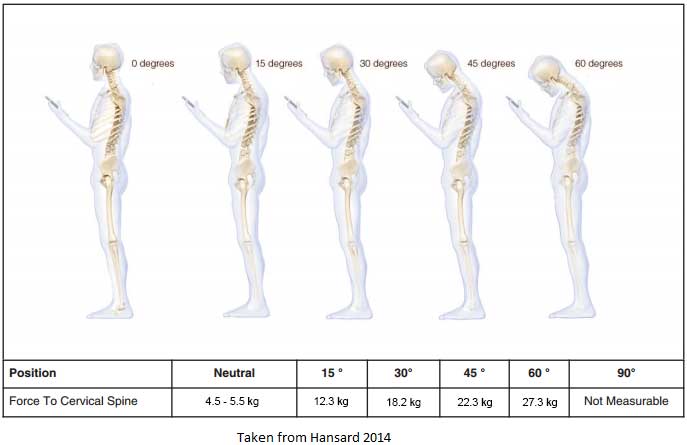According to numerous surveys, use of mobile devices (tablets, smartphones and e-readers) is growing each year. These devices are used for socialising, playing games, research and are increasingly utilised by teachers both in and out of classroom to set specific tasks to complete.
While it is great that such versatile technology is more readily available, it is the effect on the body that is most concerning to us at Back to Basics. In a 3 year study of 1049 people, “70% of adults and 30% of children and teens reported that their use of electronic devices like smart phones, tablets and laptop devices had caused neck, shoulder, wrist or finger pain”.[1]
At Back to Basics believe this has a lot to do with the neck position and posture required to operate these devices.
Forces throughout the neck are as follows:
- In a neutral neck position (0 degrees), the average human exerts a force of 4.5-5.5 kgs
- At 15 degrees, the head exerts 12.3 kgs
- At 30 degrees, the head exerts 18.2 kgs
- At 45 degrees, the head exerts 22.3 kgs
- At 60 degrees, the head exerts a force of 27.3 kgs on the cervical spine (neck)- Anyone who observes the posture of people using mobile devices knows that the posture depicted at 60 degrees is not uncommon.
The mechanical stresses caused by mobile devices lead to incrementally increased stresses about the spine. These stresses can lead to neck pain, shoulder problems, headaches and early wear and tear to the spinal joints (ie spinal degeneration). [2]
This should be a significant concern for digital media users and parents.

What Can You Do?
- Encourage the use of ergonomically designed desktop arrangements where possible
- Encourage good posture in those using mobile devices by getting them to raise the device to eye level, rather than bending their head to look down
- Encourage regular breaks that include stretching when using mobile devices
- Consult your chiropractor, to assess and correct any dysfunctional movement patterns in the neck, upper back and shoulders
References
[1] www.mensfitness.com/gear/is-your-smartphone-making-you-hunch
[2] Hansard, K (2014). Assessment of stresses in the cervical spine caused by posture and position of the head”. Neuro and Spine Surgery, Surgical Technology International XXV
[3] Dayton, L (2015). “Teens compulsive texting can cause neck injury, experts warn”. LA Times, http://latimes.com/health/la-he-text-next-20150404-story.html#page=1







